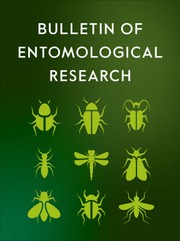Crossref Citations
This article has been cited by the following publications. This list is generated based on data provided by
Crossref.
WALL, R.
and
SMITH, K. E.
1996.
Colour discrimination by the sheep blowfly Lucilia sericata.
Medical and Veterinary Entomology,
Vol. 10,
Issue. 3,
p.
235.
1996.
Species, sub-species and hybrid populations of the blowfliesLucilia cuprinaandLucilia sericata(Diptera: Calliphoridae).
Proceedings of the Royal Society of London. Series B: Biological Sciences,
Vol. 263,
Issue. 1375,
p.
1335.
Gozlan, S.
Millot, P.
Rousset, A.
and
Fournier, D.
1997.
Test of the RAPD-PCR method to evaluate the efficacy of augmentative biological control withOrius (Het., Anthocoridae).
BioControl,
Vol. 42,
Issue. 4,
p.
593.
Stevens, Jamie
and
Wall, Richard
1997.
Genetic variation in populations of the blowflies Lucilia cuprina and Lucilia sericata (Diptera: Calliphoridae). Random amplified polymorphic DNA analysis and mitochondrial DNA sequences.
Biochemical Systematics and Ecology,
Vol. 25,
Issue. 2,
p.
81.
Stevens, Jamie
and
Wall, Richard
1997.
The evolution of ectoparasitism in the genus Lucilia (Diptera: Calliphoridae).
International Journal for Parasitology,
Vol. 27,
Issue. 1,
p.
51.
Loxdale, H.D.
and
Lushai, G.
1998.
Molecular markers in entomology.
Bulletin of Entomological Research,
Vol. 88,
Issue. 6,
p.
577.
Xu, Maolei
Sun, Shan
Wang, Rongjiang
and
Li, Shaowen
1998.
Genetic Variation and Phylogenetic Relationships Among Six Populations of Corn Borers in China.
Biochemical Genetics,
Vol. 36,
Issue. 7-8,
p.
289.
Smith, K.E.
and
Wall, R.
1998.
Estimates of population density and dispersal in the blowflyLucilia sericata(Diptera: Calliphoridae).
Bulletin of Entomological Research,
Vol. 88,
Issue. 1,
p.
65.
Sigurdsson, V.
Halldórsson, G.
Sigurgeirsson, A.
Thórsson, Æ. TH.
and
Anamthawat‐Jónsson, K.
1999.
Genetic differentiation of the green spruce aphid (Elatobium abietinum Walker), a recent invader to Iceland.
Agricultural and Forest Entomology,
Vol. 1,
Issue. 3,
p.
157.
Infante-Malachias, Maria Elena
Yotoko, Karla Suemy Clemente
and
Lima de Azeredo Espin, Ana Maria
1999.
Random amplified polymorphic DNA of screwworm fly populations (Diptera: Calliphoridae) from Southeastern Brazil and Northern Argentina.
Genome,
Vol. 42,
Issue. 4,
p.
772.
Stevens, Jamie
and
Wall, Richard
2001.
Genetic relationships between blowflies (Calliphoridae) of forensic importance.
Forensic Science International,
Vol. 120,
Issue. 1-2,
p.
116.
Otranto, Domenico
and
Stevens, Jamie R.
2002.
Molecular approaches to the study of myiasis-causing larvae.
International Journal for Parasitology,
Vol. 32,
Issue. 11,
p.
1345.
Stevens, J. R.
Wall, R.
and
Wells, J. D.
2002.
Paraphyly in Hawaiian hybrid blowfly populations and the evolutionary history of anthropophilic species.
Insect Molecular Biology,
Vol. 11,
Issue. 2,
p.
141.
Léry, Xavier
LaRue, Bernard
Cossette, Judith
and
Charpentier, Guy
2003.
Characterization and authentication of insect cell lines using RAPD markers.
Insect Biochemistry and Molecular Biology,
Vol. 33,
Issue. 10,
p.
1035.
Stevens, Jamie R
2003.
The evolution of myiasis in blowflies (Calliphoridae).
International Journal for Parasitology,
Vol. 33,
Issue. 10,
p.
1105.
Rodrigues, J. C. V.
Gallo-meagher, M.
Ochoa, R.
Childers, C. C.
and
Adams, B. J.
2004.
Mitochondrial DNA and RAPD polymorphisms in the haploid mite Brevipalpus phoenicis (Acari: Tenuipalpidae).
Experimental and Applied Acarology,
Vol. 34,
Issue. 3-4,
p.
275.
Rodrigues, J.C.V.
Gallo-meagher, M.
Ochoa, R.
Childers, C.C.
and
Adams, B.J.
2004.
Mitochondrial DNA and RAPD polymorphisms in the haploid mite Brevipalpus phoenicis (Acari: Tenuipalpidae).
Experimental & Applied Acarology,
Vol. 34,
Issue. 3-4,
p.
275.
de Azeredo-Espin, Ana Maria Lima
and
Lessinger, Ana Cláudia
2006.
Genetic Approaches for Studying Myiasis-causing Flies: Molecular Markers and Mitochondrial Genomics.
Genetica,
Vol. 126,
Issue. 1-2,
p.
111.
Patil, Suvama
Bashasab, Fakmdin
Vijaykumar
Basavanagoud
Kuruvinashetti, Mahaling S
and
Patil, Basavaraj V
2006.
Genetic relatedness among Helicoverpa armigera (Hübner) occurring on different host plants as revealed by random amplified polymorphic DNA markers.
Journal of Asia-Pacific Entomology,
Vol. 9,
Issue. 3,
p.
227.
Mikac, K.M.
and
Clarke, G.M.
2006.
Tracing the geographic origin of the cosmopolitan parthenogenetic insect pest Liposcelis bostrychophila (Psocoptera: Liposcelididae).
Bulletin of Entomological Research,
Vol. 96,
Issue. 5,
p.
523.

